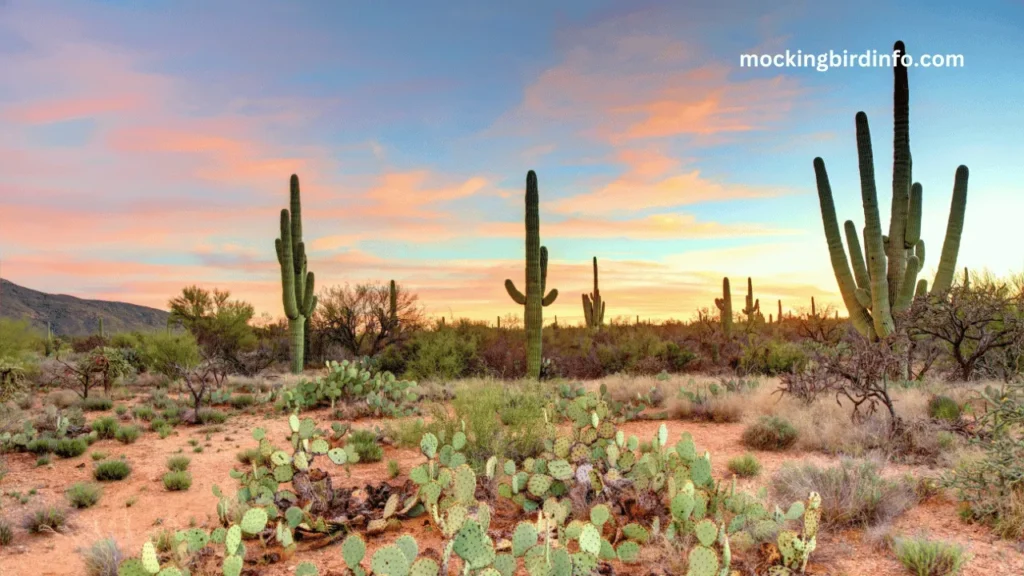As the sun sets over the Arizona desert, a familiar melody echoes through the air—the song of a mockingbird, rich with the sounds of other birds and even human-made noises. It’s a captivating moment when you realize the bird you’re hearing is not only adapting to its environment but thriving in it.
Mockingbirds, known for their remarkable ability to mimic a range of sounds, are one of the most common and beloved birds in Arizona. But, do they really call the Grand Canyon State home? The answer is yes—Arizona is filled with these fascinating creatures, and they are a constant presence in many parts of the state.
Mockingbirds have become a fixture of Arizona’s landscapes, found in everything from bustling cities to the wide open desert. Their versatility and adaptability make them perfectly suited for the state’s unique ecosystems.
In this article, we will explore where you can find mockingbirds in Arizona, the habitats they prefer, and the factors that allow them to flourish in such a diverse environment. From urban neighborhoods to the vast desert plains, these birds have found a way to make Arizona their home year-round.
Join us as we delve into the world of mockingbirds in Arizona, uncovering their ecological role, their impressive survival strategies, and the important conservation efforts necessary to ensure their continued success in this desert oasis.

Contents
Distribution of Mockingbirds in Arizona
Mockingbirds are found across the entire state of Arizona, with populations thriving in both urban and rural areas. In cities like Phoenix, Tucson, and Scottsdale, these birds have become an iconic presence, filling the air with their distinctive calls.
They are commonly spotted in parks, gardens, and backyards, where they have adapted well to human-modified landscapes.While mockingbirds can be found in suburban areas, they are also equally at home in the rural deserts of Arizona.
The Sonoran Desert, with its wide open spaces and varied vegetation, offers an ideal environment for these birds. Mockingbirds are known for their territorial behavior and often stake out large areas as their own.
Their ability to adapt to urbanization and thrive in more natural, remote areas makes them a symbol of resilience in Arizona’s landscape. Seasonally, mockingbird populations in Arizona tend to be resident, with birds remaining in the state year-round.
However, migratory patterns can be observed in certain regions, particularly in higher elevations where the climate becomes cooler in the winter months. In these areas, mockingbirds may move to lower, more temperate regions, but in general, Arizona’s mild winters ensure that mockingbirds are abundant and active throughout the year.
Habitat Preferences
Mockingbirds are highly adaptable and can live in a range of habitats across Arizona. From the lush riparian zones along the state’s rivers to the arid desert scrub, mockingbirds are found in many ecosystems.
They are particularly drawn to urban gardens, parks, and agricultural lands, where dense vegetation provides ample opportunities for nesting and foraging.
One of the key factors influencing mockingbird habitat choice is the availability of nesting sites. Mockingbirds typically build their nests in trees, shrubs, or even man-made structures like telephone poles and fences.
These versatile birds use a wide variety of locations to make their homes, ensuring that they can thrive even in heavily developed areas. In rural and desert regions, they often choose thorny bushes or cacti as nesting sites to provide extra protection from predators.
Food availability is another crucial factor in determining suitable habitats for mockingbirds. In Arizona, these birds feed on a wide variety of foods, including insects, fruits, seeds, and even small reptiles.
Areas with abundant food sources, such as agricultural fields, fruit trees, and flowering plants, are ideal for mockingbirds. Their omnivorous diet allows them to thrive in diverse environments, contributing to their widespread presence across Arizona.

Factors Contributing to Mockingbird Success in Arizona
Several factors contribute to the success of mockingbirds in Arizona, starting with the state’s mild climate. The warm temperatures, especially in the winter months, provide a comfortable environment for these birds, allowing them to remain active and thrive throughout the year.
The abundant sunshine and minimal rainfall in many parts of the state ensure that mockingbirds have consistent access to food and shelter. In addition to the climate, Arizona’s abundant food sources are a significant factor in the success of mockingbirds.
The availability of insects, fruits, and seeds throughout much of the year supports healthy populations of mockingbirds. Arizona’s desert vegetation, which includes cacti, yucca, and acacia, provides both food and nesting sites for mockingbirds, allowing them to flourish in even the harshest desert environments.
Another factor contributing to mockingbird success in Arizona is the lack of natural predators. While mockingbirds do face some threats from larger birds of prey, such as hawks and eagles, Arizona’s environment provides fewer natural predators compared to other regions.
This allows mockingbird populations to thrive without the constant pressure of predation, making it easier for them to establish territories and reproduce. Human influence has also played a role in the success of mockingbirds in Arizona.
Many people in the state landscape their yards with fruit trees, shrubs, and flowering plants, creating ideal environments for mockingbirds. Additionally, bird feeders stocked with seeds and nectar attract mockingbirds to suburban areas, further supporting their populations.
The Role of Mockingbirds in Arizona’s Ecosystem
Mockingbirds are not only a charming addition to Arizona’s landscapes but also play a significant role in maintaining the ecological balance. One of their most important functions is seed dispersal, which helps to maintain and regenerate plant communities.
By consuming fruits and berries and passing the seeds in their droppings, mockingbirds aid in the spread of various plant species across the state, including important desert vegetation. Mockingbirds also play a crucial role in insect control.
As omnivores, they feed on a variety of insects, including grasshoppers, caterpillars, and beetles, helping to manage insect populations. This benefits not only the natural environment but also agriculture in Arizona, where crops can be damaged by excessive insect activity.
By keeping insect populations in check, mockingbirds contribute to the health of both wild and cultivated ecosystems. In addition to their direct ecological benefits, mockingbirds also serve as indicators of environmental health.
The presence of these birds in an area can signal a healthy, balanced ecosystem. Their ability to thrive in human-modified environments, as well as their reliance on native plants and insects, makes them an important part of Arizona’s biodiversity.
Conclusion
In conclusion, Arizona is a prime habitat for mockingbirds, which thrive in the state’s diverse environments, from urban gardens to the wild desert landscapes. Their ability to adapt to various habitats, along with the mild climate, abundant food sources, and limited natural predators, contributes to their success in Arizona.
Mockingbirds also play an essential role in maintaining the state’s ecological balance, from seed dispersal to insect control. As Arizona continues to grow and change, it is crucial to protect the habitats that support mockingbird populations.
Conservation efforts that focus on preserving native plants, green spaces, and natural habitats are essential to ensure that mockingbirds remain a vibrant part of Arizona’s biodiversity for generations to come.
Whether you’re spotting them in your own backyard or hearing their songs echoing through the desert, mockingbirds are a reminder of the beauty and complexity of Arizona’s natural world.
FAQs
1. Do Arizona have mockingbirds?
Yes, Arizona is home to mockingbirds, particularly the Northern Mockingbird, which is commonly found in both urban and rural areas across the state.
2. Where are mockingbirds found in Arizona?
Mockingbirds can be found throughout Arizona, from urban gardens and parks in cities like Phoenix to the desert scrub and riparian zones in rural areas.
3. What do mockingbirds eat in Arizona?
Mockingbirds have an omnivorous diet, eating insects, fruits, seeds, and sometimes small reptiles.
4. Do mockingbirds migrate in Arizona?
While mockingbirds are generally resident in Arizona, they may migrate to lower elevations during cooler winter months in higher regions.
5. Why are mockingbirds important to Arizona’s ecosystem?
Mockingbirds contribute to seed dispersal, insect control, and act as indicators of environmental health, supporting plant diversity and biodiversity.
6. How do mockingbirds adapt to urban environments in Arizona?
Mockingbirds thrive in urban areas by nesting in trees, shrubs, and man-made structures, and they benefit from human-provided food sources like bird feeders.








